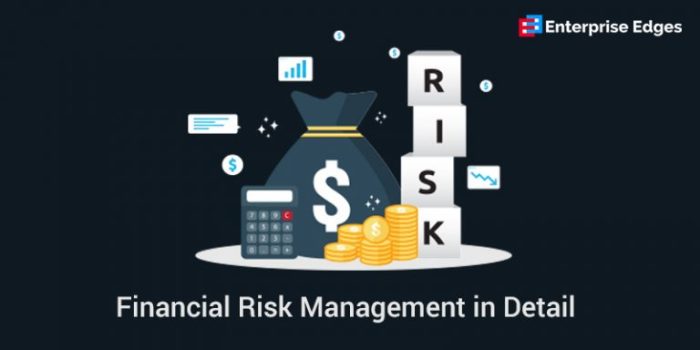With risk management in finance at the forefront, this paragraph opens a window to an amazing start and intrigue, inviting readers to embark on a storytelling american high school hip style filled with unexpected twists and insights.
Risk management in finance is a crucial aspect of the financial industry, ensuring stability and security in an ever-changing landscape. From identifying risks to implementing strategies, the world of finance is a complex web of calculations and decisions that can make or break institutions. Let’s dive into the realm of risk management and explore the key elements that drive financial success.
Overview of Risk Management in Finance
Risk management plays a crucial role in the financial industry, helping institutions identify, assess, and mitigate potential risks that could impact their operations, finances, and reputation. By effectively managing risks, financial institutions can protect themselves from unexpected events and uncertainties, ensuring stability and sustainability in the long run.
Types of Risks Managed in Finance
- Credit Risk: The risk of borrowers defaulting on their loans or debt obligations.
- Market Risk: The risk of financial losses due to changes in market conditions, such as interest rates, exchange rates, or commodity prices.
- Operational Risk: The risk of losses resulting from inadequate or failed internal processes, systems, or human errors.
Enhancing Financial Stability Through Effective Risk Management
Effective risk management practices can enhance financial stability by ensuring that institutions have the necessary safeguards and strategies in place to address potential risks proactively. For example, by diversifying investments, monitoring market trends, and implementing robust internal controls, financial institutions can reduce their exposure to risks and improve their overall resilience to external shocks.
Role of Regulations in Shaping Risk Management Practices
Regulations play a significant role in shaping risk management practices in the finance industry by establishing guidelines and standards that institutions must adhere to. These regulations help ensure transparency, accountability, and compliance with best practices, ultimately promoting a safer and more stable financial system for all stakeholders.
Risk Identification and Assessment
Risk identification and assessment are crucial steps in managing financial risks. By identifying potential risks and evaluating their impact, companies can make informed decisions to mitigate these risks and protect their financial well-being.
Tools and Techniques for Risk Identification and Assessment
- SWOT Analysis: Examining Strengths, Weaknesses, Opportunities, and Threats
- Scenario Analysis: Creating different scenarios to understand potential risks
- Checklists: Using predefined checklists to identify common risks
- Brainstorming: Gathering input from various stakeholders to uncover risks
Qualitative vs. Quantitative Methods for Evaluating Risks
- Qualitative Methods: Focus on descriptive analysis and subjective judgments
- Quantitative Methods: Involve numerical data and statistical analysis
Real-Life Examples of Risk Identification and Assessment
“After conducting a SWOT analysis, our company identified a potential risk of increased competition in the market. This insight influenced our decision to diversify our product offerings to mitigate this risk.”
“Using scenario analysis, we were able to anticipate the impact of a global economic downturn on our investments. This allowed us to adjust our portfolio to minimize potential losses.”
Risk Mitigation Strategies

When it comes to managing financial risks, it’s crucial to have effective mitigation strategies in place to protect your investments. By implementing the right techniques, you can minimize potential losses and safeguard your assets. Let’s dive into some common strategies used in risk mitigation in finance.
Diversification as a Risk Mitigation Technique
Diversification is a key strategy in risk management that involves spreading your investments across different asset classes, industries, and geographical regions. By diversifying your portfolio, you can reduce the impact of a single investment’s poor performance on your overall wealth. This technique helps to lower the risk of significant losses and provides a more stable return on investment.
Use of Derivatives in Risk Management
Derivatives are financial instruments that derive their value from an underlying asset or security. In risk management, derivatives like options, futures, and swaps are commonly used to hedge against price fluctuations, interest rate changes, and other market risks. For example, a company can use futures contracts to lock in a specific price for a commodity, protecting against potential price increases in the future.
Role of Insurance in Hedging Financial Risks
Insurance plays a crucial role in hedging against financial risks by transferring the risk of potential losses to an insurance company. Whether it’s health insurance, property insurance, or business interruption insurance, having the right coverage can help mitigate the financial impact of unexpected events. By paying premiums, individuals and businesses can protect themselves from significant financial losses due to unforeseen circumstances.
Risk Monitoring and Control
Continuous monitoring of risks in finance is crucial to ensure the stability and success of an organization. By keeping a close eye on potential risks, financial institutions can proactively address issues before they escalate into larger problems that could lead to financial losses.
Importance of Continuous Monitoring
Continuous monitoring allows organizations to stay ahead of potential risks, identify emerging threats, and adapt their risk management strategies accordingly. It enables real-time assessment of the effectiveness of risk mitigation strategies and helps in making informed decisions to protect the financial well-being of the institution.
Methods for Tracking and Controlling Risks
- Utilizing risk management software to track and analyze risks in real-time.
- Implementing regular risk assessments and audits to identify vulnerabilities.
- Establishing clear communication channels for reporting and addressing risks promptly.
Role of Key Performance Indicators (KPIs)
Key performance indicators (KPIs) play a vital role in risk management by providing measurable criteria to evaluate the effectiveness of risk control measures. By tracking relevant KPIs, organizations can monitor their performance in managing risks and make data-driven decisions to enhance their risk management strategies.
Implementation of Risk Control Mechanisms
- Setting up automated alerts and triggers to flag potential risks in real-time.
- Establishing clear protocols and procedures for responding to identified risks promptly.
- Regularly reviewing and updating risk control mechanisms to adapt to changing market conditions and emerging threats.
